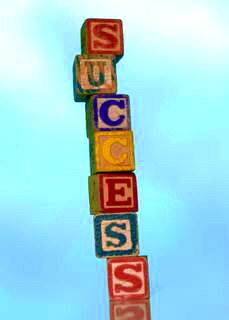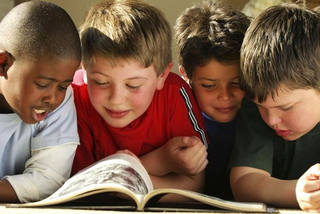Learn How to Teach Phonics
Step By Step
In this article I will show you the crucial early stages of how to teach phonics to your child.
I plan to take you step by step, in a systematic way, so that nothing
important is missed. Many early readers do not learn this stage thoroughly
enough and end up confused.The secret is in following these simple steps of how to teach phonics.
If it's taught well, your child
will develop the skill to sound out (without guessing) at least 100 words by the time
they are around 5-6 years of age.
Learning Letter Sounds
I'll show you how to teach phonics using methods I know work exceptionally well, with both children and adults.
The first level in how to teach phonics involves showing your student how to recognise the sounds of the alphabet letters.
So that your child doesn’t muddle letter names with the sounds letters make, focus solely on the sounds. Don’t ask them to sing or chant the alphabet letters. It will only confuse them at this stage.
Many children from the age of 4 can effortlessly learn the names of the letters of the alphabet by singing the Alphabet Song. It is important that they do learn the letter names but focus your time at this stage on
teaching them the sounds the letters make, which is a new and greater challenge.

Gauge Your Child's Pace
At kindergarten or in their first year of school your child may be taught one letter sound a week. This also probably involves learning to write the associated letter. It's possible that they are capable of learning more sounds than this. Every child is different.
It's important that you teach your child at their pace, not yours. You might find 5-10 minutes is a long enough period to spend at a time. Or they might be prepared to work for 30 minutes. It all depends on their attention span.
Remember that if you are working with your child
after a full day at school they may be tired. Keep your interactions with them
light and fun. Avoid stressing them or they will switch off.
Teach In This Order
I’ll let you into the first secret of how to teach phonics. You don’t need to teach your child the alphabet sounds in their normal sequence …a b c d.
Their classroom teacher might have a particular sequence of letters they want their class to learn. Chat with them about this and ask if it is appropriate for you to do some teaching at home. Try, where possible, to work in with the teacher as it will make your child’s learning easier at school.
I teach the sounds in this order.
a m s t c r b f h d n v p e l j w i g o k u q x y z.
The sounds do not have to be taught in the exact sequence above but I have found this format works exceptionally well for my students.
I’m showing you how to teach phonics using this sequence for several reasons
- The first sounds on the list can be combined to make a large bank of words which can be sounded out. This means that your child can start learning to read words as soon as they know a few sounds.
- Children will not need to read letters like q nearly as frequently as a and m. So it makes sense to learn the sounds a and m before q.
- At this stage, they're learning to recognise the shapes of letters. It's important that they aren’t taught letters like h and n or d p b one after the other. Letters with similar shapes often confuse new readers.
- Some early reading books are based on a similar logical sequence of sounds as those above. It helps to learn a few sounds and then read books which contain words using those sounds.
Start Blending Sounds When Your Child is Capable
Teach children how to blend sounds together as soon as they have learned a few of the alphabet sounds. Many can do this between the ages of 4 and 5 years.
As soon as they know that the letter a says a as in the word apple
and m says mmmm as in the word mountain
they can begin. Follow on with as and
at. I have explained this in a lot of detail on
my Free Phonics Lesson page.

Don't Encourage Your Child to Guess
One of the most important lessons in how to teach phonics involves not allowing your child to guess words.
Ask them to sound each word out. Do not tell them what the word says. They need to work it out by themselves, sound-by-sound from left to right. This teaches them that they can tackle words and decode them without fear.
Guide them gently but don't tell them. If they are stuck, help them to work out just the sound, without telling them the whole word.
A word of warning: Teachers often send “readers” or small books home to be read for homework. Children enjoy these. After reading them with you a few times some children seem to be able to read them without help. That’s often because the repetition and colourful pictures contained in them make it possible for them to memorise the words.
Children who guess words rather than sounding them out have developed bad habits. They aren’t really reading. Guessing or memorising words is a difficult habit to break. Teach them decoding skills from the beginning.
Sight Words Are Different
Most words your child will come across need to be decoded or sounded out. There are some words, however, that can’t be quickly and easily decoded. These are called sight words. Your child is required to learn many of them in their first two years at school.
Sight words are lists of words that are most often used when we read and write. They are taught as sight words because
- Many of the words can’t be sounded out easily so have to be learned so they are quickly recognised.
- New readers need a bank of useful words so that they can read and write sentences. Some sight words are important linking words that add “glue” to sentences in the early stages of reading.
Examples include …I the me here that went to said come
Teachers
will give your child sight words to learn in a series of small lists. It is
important that you don’t make up lists of your own as you could upset the
structured reading process. These words have been carefully researched and are
understood to be the most useful. For more on how important sight words are click on What are Sight Words.
Blending Words With Three Letters
If you want to know how to teach phonics at the next level, introduce three-letter words, each with a vowel in the middle.
These are referred to by teachers as CVCs (which simply means consonant, vowel, consonant.) Teachers also refer to them as word families because they have sounds in common.
1. As your child has already learned how to blend m, you could start with three-letter words in the am word family.
Try these: ham Sam dam jam, pam, ram, yam
Blend them smoothly together from left to right. Tell your child to s-t-r-e-t-c-h each sound.
2. The at family comes next and includes words like cat fat sat rat hat
3. This is followed by the an family, can, man ran pan then the et family, met pet set let bet get
4. Continue with other words families which have different vowels and endings, for example, bit hot mud tub
5. Once they have mastered the five different vowels, see if they can read, smoothly, the following words
jet man lip
sat fog cup
bed wag dot
gap hot fox vet
How To Teach Phonics From Here
The next stage is to learn Consonant Blends.
They can occur at the beginning, middle or end
of a word. It is easier to learn consonant blends that occur at the beginning of words
first … blends like …pl as in plan, sp as in spot, cr as in crab ...
then end blends like …lk as in milk, nd as in hand, nk as in blink
Once your child reaches this point, they will be capable of reading many words.
For step by step help on how to teach this stage ... plus examples of all types of blends readers encounter...click on this popular article, Consonant Blends.
Be assured that as your child masters these first
steps, they are well on their way to becoming competent readers. It will be one of the greatest gifts you can give them.
Go From How to Teach Phonics to Teaching Phonics




